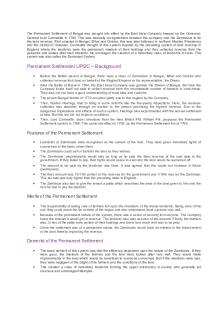Ryotwari settlement PDF

| Title | Ryotwari settlement |
|---|---|
| Author | Davaar's Dairy |
| Course | LLB Semester 4 SUCL |
| Institution | Osmania University |
| Pages | 1 |
| File Size | 88.3 KB |
| File Type | |
| Total Downloads | 116 |
| Total Views | 138 |
Summary
Ryotwari settlement...
Description
Ryotwari settlement Ryotwari system: ‘Ryot’ means individual cultivator, peasant, subject and tenant of land, ‘Ryotwari’ is the arrangement about rent made annually in India, directly between the Government and the ryots. # This system of land revenue was instituted in the late 18th century by Sir Thomas Munro, Governor of Madras in 1820. # This was practised in the Madras and Bombay areas, as well as Assam and Coorg provinces. # In this system, the peasants or cultivators were regarded as the owners of the land. They had ownership rights, could sell, mortgage or gift the land. # The taxes were directly collected by the government from the peasants. # The rates were 50% in dryland and 60% in the wetland. # The rates were high and unlike in the Permanent System, they were open to being increased. # If they failed to pay the taxes, they were evicted by the government. # Ryot means peasant cultivators. # Here there were no middlemen as in the Zamindari system. But, since high taxes had to be paid only in cash (no option of paying in kind as before the British) the problem of moneylenders came into the show. They further burdened the peasants with heavy interests. # The revenue assessment is announced by the land-owner, when the tenant objects, he is heard and may be able to sustain his plea for an abatement, so that there is really, a settlement in that sense. Ryotwari system is one of the three principal methods of revenue collection in British India. It was prevalent in most of southern India, being the standard system of the Madras Presidency (a British controlled area now constituting much of present-day Tamil Nadu and portions of neighbouring states). The system was devised by Capt. Alexander Read and Thomas (later Sir Thomas) Munro at the end of the 18th century and introduced by the latter when he was governor (1820–27) of Madras (now Chennai). The principle was the direct collection of the land revenue from each cultivator by government agents. For this purpose, all holdings were measured and assessed according to crop potential and actual cultivation. The advantages of this system were the elimination of middlemen, who often oppressed villagers, and an assessment of the tax on land actually cultivated and not merely occupied. Offsetting these advantages was the cost of detailed measurement and of the individual collection. This system also gave much power to subordinate revenue officials, whose activities were inadequately supervised. The name of the system comes from the word ryot, an Anglicization by the British in India of the Arabic word raʿīyah, meaning a peasant or cultivator. The Arabic word passed into Persian (raʿeyyat) and was carried by the Mughals, who used it throughout India in their revenue administration. The British borrowed the word from them and continued to use it for revenue purposes in the Anglicized form. The word has passed into various Indian languages, but in northern India, the Hindi term Kisan is generally used.
1|P a ge
Compil Compiled ed By Davaar msa...
Similar Free PDFs

Ryotwari settlement
- 1 Pages

Settlement agreement
- 5 Pages

Settlement Summary
- 2 Pages

Settlement/part 36 offer
- 4 Pages

Settlement Agreement (LLW1003)
- 5 Pages

Settlement AND PART 36 Offers
- 4 Pages

Family+Law+Property+Settlement+Guide
- 19 Pages

Settlement OF Disputes and ICJ
- 4 Pages
Popular Institutions
- Tinajero National High School - Annex
- Politeknik Caltex Riau
- Yokohama City University
- SGT University
- University of Al-Qadisiyah
- Divine Word College of Vigan
- Techniek College Rotterdam
- Universidade de Santiago
- Universiti Teknologi MARA Cawangan Johor Kampus Pasir Gudang
- Poltekkes Kemenkes Yogyakarta
- Baguio City National High School
- Colegio san marcos
- preparatoria uno
- Centro de Bachillerato Tecnológico Industrial y de Servicios No. 107
- Dalian Maritime University
- Quang Trung Secondary School
- Colegio Tecnológico en Informática
- Corporación Regional de Educación Superior
- Grupo CEDVA
- Dar Al Uloom University
- Centro de Estudios Preuniversitarios de la Universidad Nacional de Ingeniería
- 上智大学
- Aakash International School, Nuna Majara
- San Felipe Neri Catholic School
- Kang Chiao International School - New Taipei City
- Misamis Occidental National High School
- Institución Educativa Escuela Normal Juan Ladrilleros
- Kolehiyo ng Pantukan
- Batanes State College
- Instituto Continental
- Sekolah Menengah Kejuruan Kesehatan Kaltara (Tarakan)
- Colegio de La Inmaculada Concepcion - Cebu







